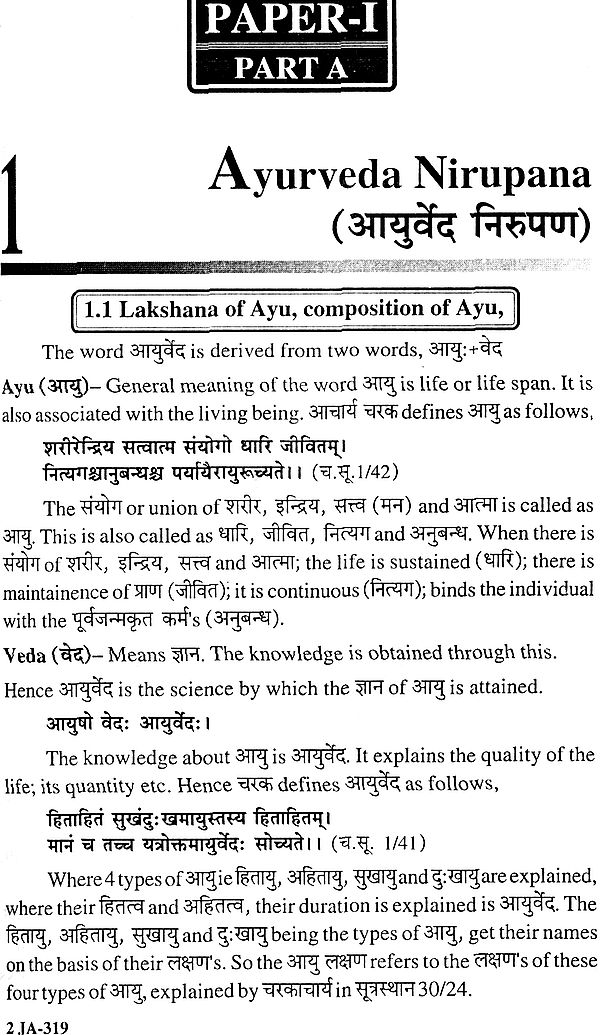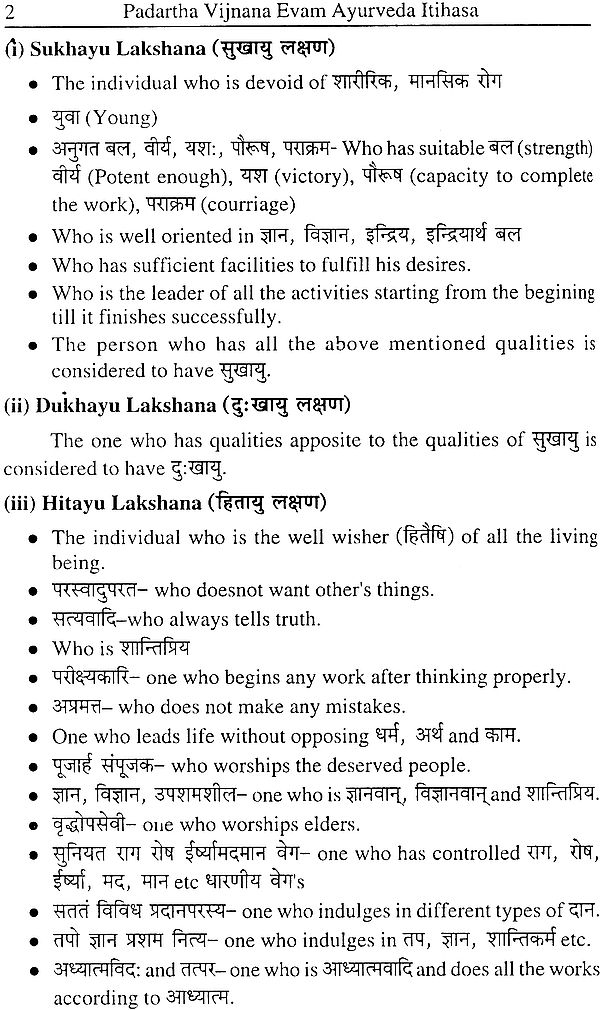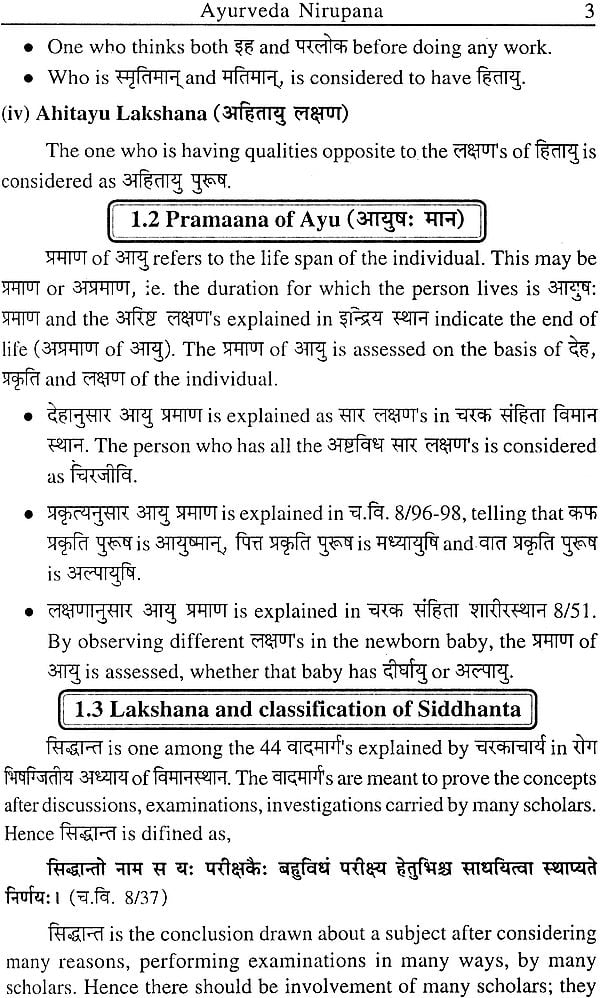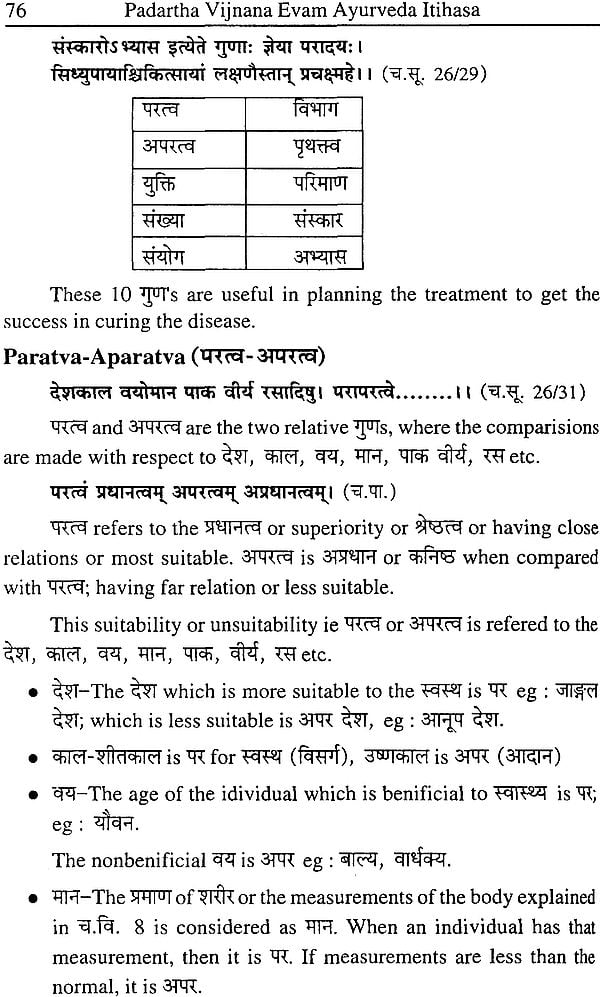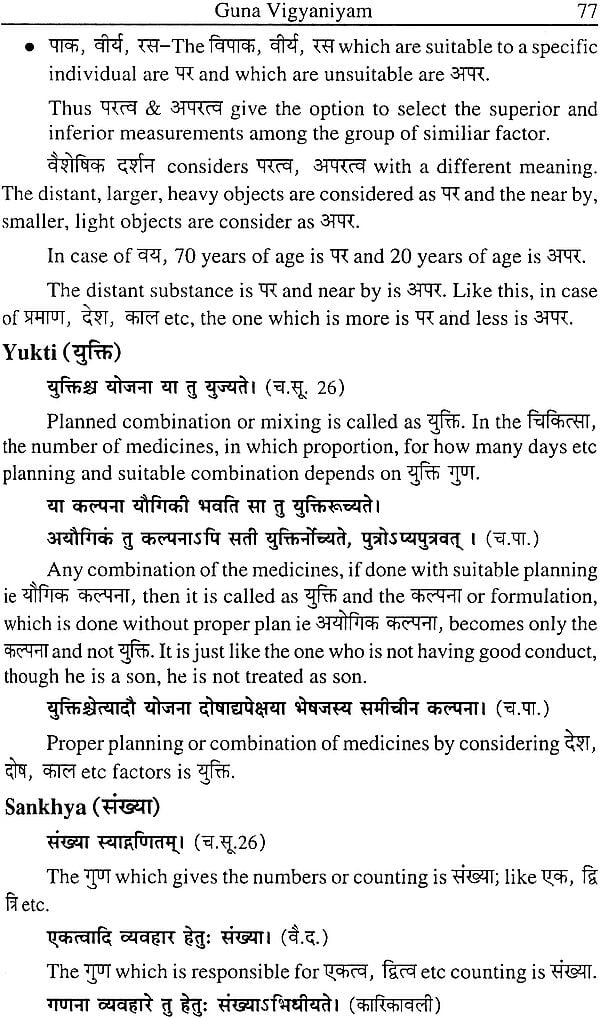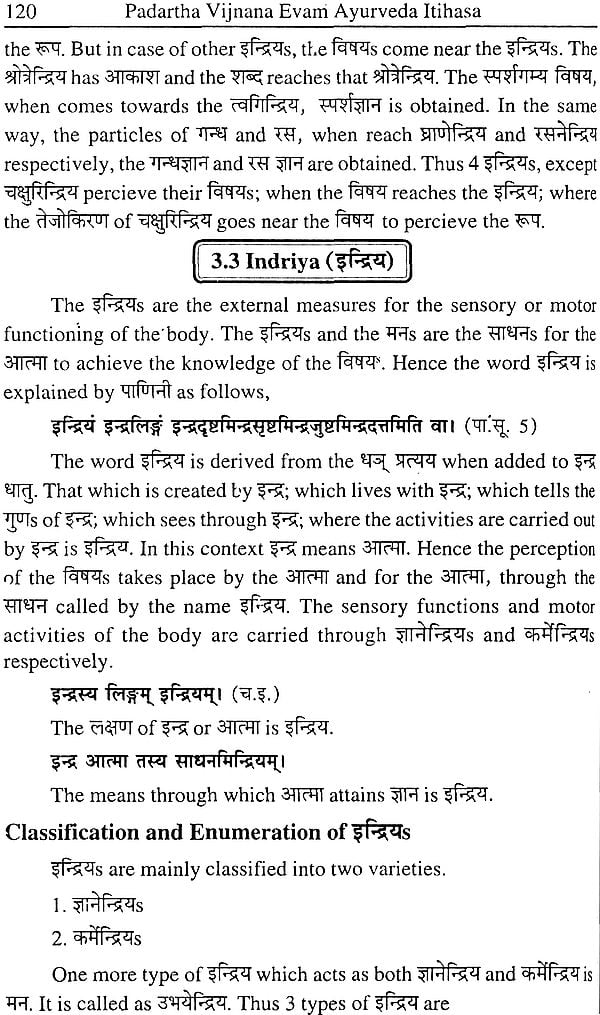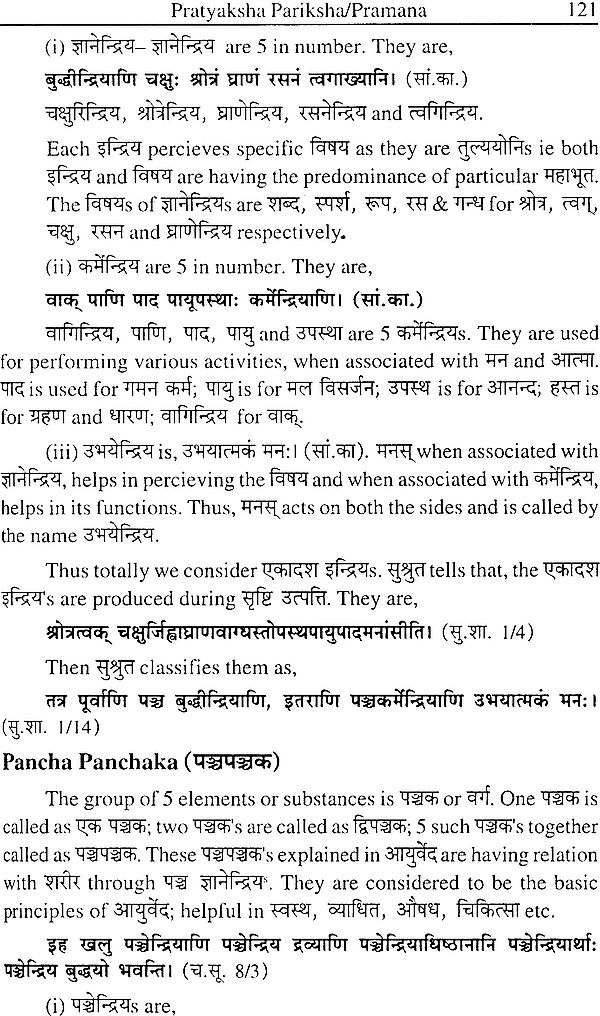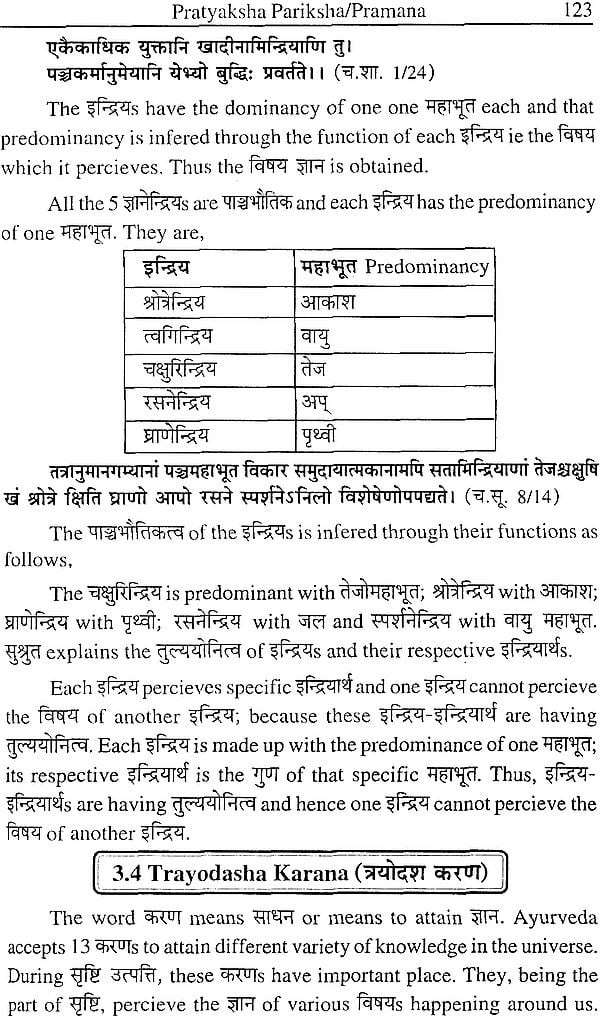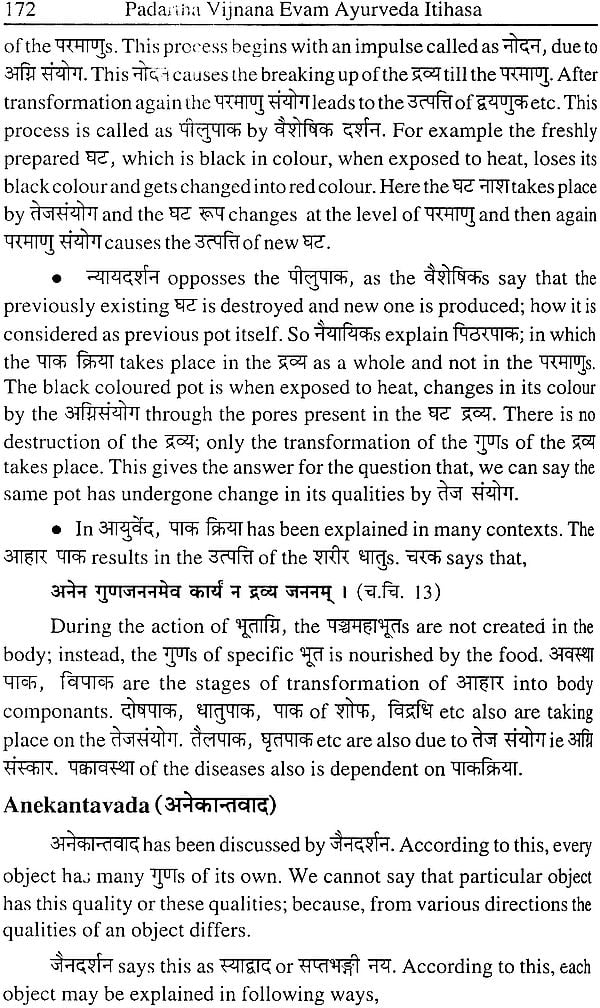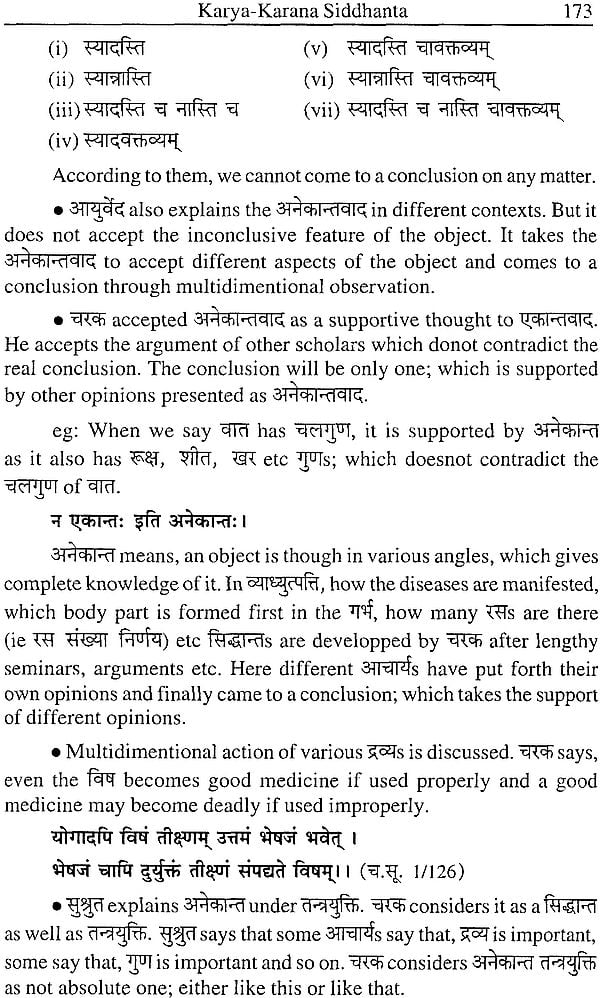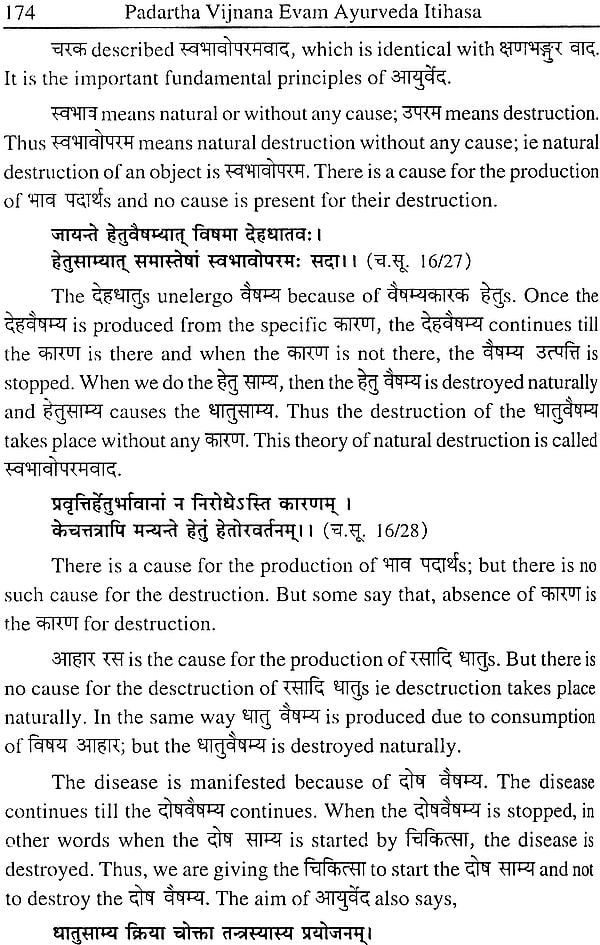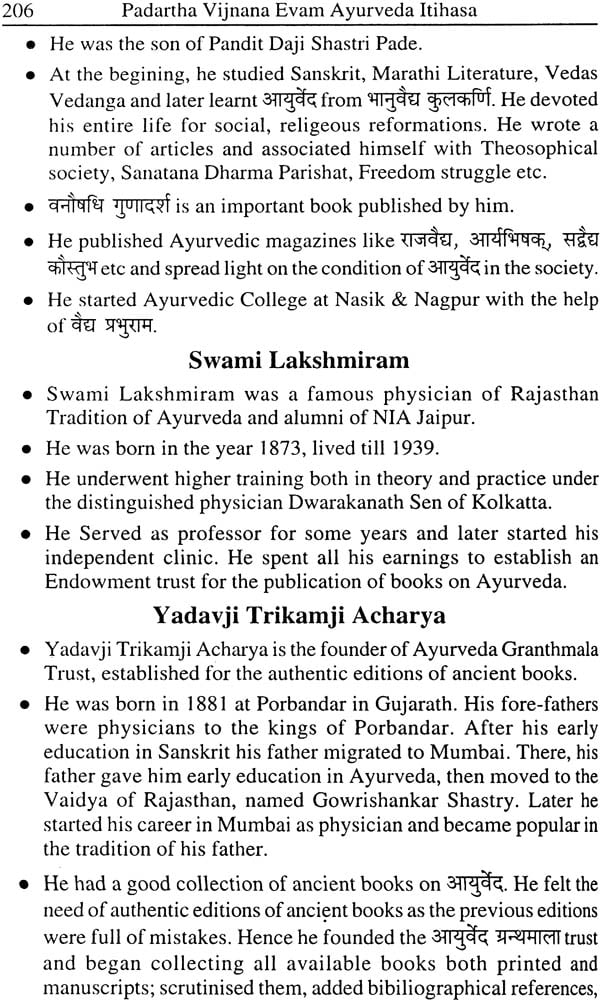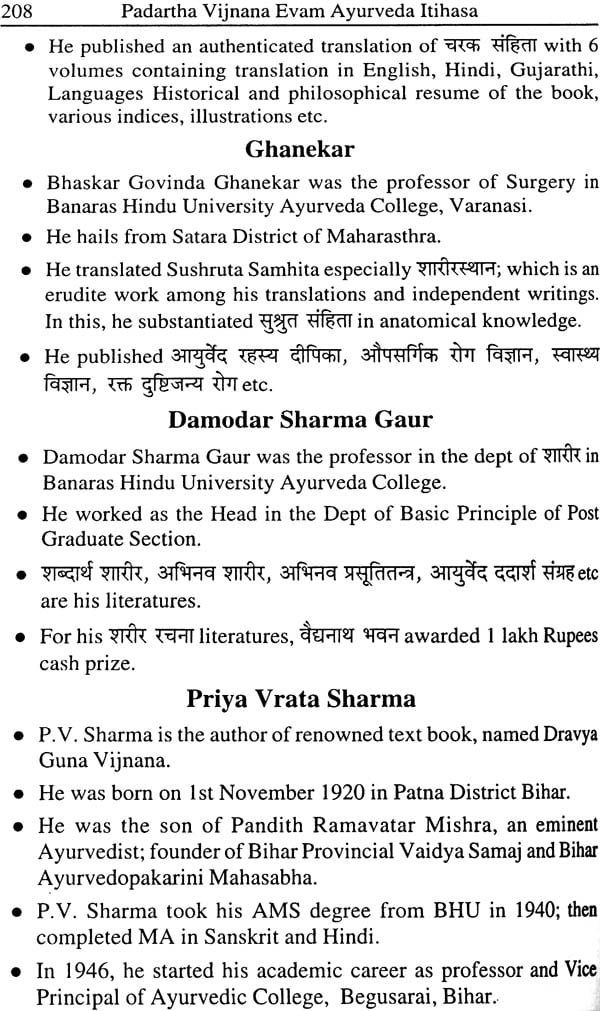
Padartha Vijnana Evam Ayurveda Itihasa
Book Specification
| Item Code: | NAN438 |
| Author: | Dr. Vidyalakshmi K. and Dr. Shrikanth |
| Publisher: | Chaukhambha Orientalia |
| Language: | Sanskrit and English |
| Edition: | 2016 |
| ISBN: | 9788176373791 |
| Pages: | 248 |
| Cover: | Paperback |
| Other Details | 8.5 inch X 5.5 inch |
| Weight | 240 gm |
Book Description
About the Book
Padartha Vijnana Evam Ayurveda Ithihas, a comprehensive book in accordance with the revised syllabus prescribed by CCIM, New Delhi has been presented in English with Sanskrit words in Devnagari script as well, to meet the needs of the Ayurvedic students. In the book, the entire subject is discussed in detail with the help of a number of original shloka, handful of tables, examples, applied aspects wherever necessary. This book will certainly fulfill the requirements of undergraduate students and will be a guide for Post Graduate students and also will be useful for the teaching profession.
About the Authors
Dr. Vidyalakshmi K. is a leading academician in the field of Ayurveda. She is working as associate professor in the Department of Basic Principles in Shri Dharmasthala Manjunatheshwara College of Ayurveda, Kuthpady, Udupi, Karnataka. She is teaching Ayurveda Padartha Vijnana and Ayurveda ltihasa since 8 years. She completed her BAMS from KVG Ayurveda Medical College, Sullia in the year 2003 and Post Graduation in Ayurveda Siddhanta from Dr. BNMET's Shri Mallikarjuna Swami PG and Research Centre, Bijapur in 2008. Immediately started her academic carrier in SDM college of Ayurveda, Udupi. She has completed her MA (Sanskrit) from Karnataka State Open Univrsity, Mysore during 20•11-12 with distinction. She is the recognised guide for Post Graduation in Samhita Siddhanta in Rajiv Gandhi University of Health Sciences, Bangalore. She is the examiner, paper setter for RGUHS Bangalore, Amruta Ayurveda University, Kollam, KLE University, Belgam etc. She has prepared around 600 mcqs in Padartha Vijnana and Ayurveda Ithihasa for the question bank. She has attended as resource person, paper presenter and delegate in many National and International Seminars, CME; ROTP at different parts of the country. She has published many scientific articles in reputed indexed pubmed journals.
Dr. Shrikanth P. H. is presently working as Head and Professor in the Department of Samhita and Siddhanta, SDM College of Ayurveda, Udupi. He completed his BAMS from SDM College of Ayurveda, Udupi in 1998 and MD in Basic Principles from IPGT and R. Gujarat Ayurveda University, Jamnagar in 2002. Since then he has worked in MIAMS, Manipal and PAMC Parassinikkadavu, dealing with subjects like Padartha Vigyan, Astanga Hridaya, Ayurveda Ithihasa, Charaka Sarnhita for BAMS and Basic Principles for Post Graduate Scholars. He is the guide for P.G. examiner and paper setter for both B.A.M.S. and M.D. He is the co-author of Sacitra Charaka Samhita' published by MIAMS, Manipal. He has published many articles in reputed journals. He participate as resource person for CME, ROTP and seminars.
To understand the principles of Ayurveda, the basis of Padartha Vijnana is essential. But: most of the times, the study of the subject is neglected by the students as well as the teaching community. As the subject is taught in the first year of undergraduate education, students find it difficult to adjust to the precepts of philosophy. By the time they start their career, the would be out of touch with the subject. The teachers are often blamed for this paradoxical situation.
Dr. Vidyalakshmi, the author of this book, has effectively taught the subject to the students for many years. Herk communication skills and depth of the knowledge are reflected in the book. I hope the student community will find this book useful to create interest in the subject, as well as meet the needs of the examination.
I hope, the author would write more books in future benefiting the science of Ayurveda.
Padartha Vijnana means the science which deals with the substances in the universe, its relationship with the living being in terms of their properties, functions; methods of understanding them etc. Generally the subject Padartha Vigyan is considered as tough in the field of Ayurveda. But, it is the most useful subject than any other in Ayurveda. The topics dealt in it are the fundamental concepts of Ayurveda on which entire chikitsa stands. Understanding the eliments in the universe is mandatory before studying the body. The components of the universe are studied as "Shad Padartha" in Padartha Vijnana. Samanya Vishesha Siddhanta, Panchamahabhuta, Atma, Kaala, Dik, Manas, Guna, Karma, Samavaya include all the substances with their properties, functions and their mutual relationship. Philosophical background of concepts of Ayurveda are discussed in Darshanas; Cause and Effect are explained through different Karya-Kaarana Siddhanta. The methods of understanding the shastra is through the help of pareeksha/pramana. Studying Ayurveda Itihasa in terms of important historical persons, their place, time, family, impact on Ayurveda etc is the need of the BAMS students before the study of proper subjects.
In this book, subject matter is discussed with the help of different darshanas and other shastras which are correlated with Ayurveda System. Hence this book "Padartha Vijnana Evam Ayurveda Itihasa" will be a good guide for the BAMS students; as it includes all the subject matters in accordence to the revised syllabus prescribed by CCIM, New Delhi.
Contents
| | ||
| | ||
| 1 | Ayurveda Nirupana | 1-6 |
| 1.1 | Lakshana of Ayurveda | 1 |
| 1.2 | Lakshana of Ayurveda | 3 |
| 1.3 | Lakshana and classification of Siddhanta | 3 |
| 1.4 | Introduction to basic priciples of Ayurveda and their significance | 5 |
| 2 | Ayurveda Darshana Nirupana | 7-19 |
| 2.1 | Philosophical bacground of fundamentals of Ayurveda | 7 |
| 2.2 | Etymological derivation of the word "Darshana" | 8 |
| 2.3 | Classification and general introduction to schools of Indian philosophy | 8 |
| Nyaya Darshana | 10 | |
| Vaisheshika Darshana | 11 | |
| Saankhya Darshana | 13 | |
| Yoga Darshana | 13 | |
| 2.4 | Padartha | 16 |
| Padartha Lakshana | 17 | |
| Enumeration and classification of padartha | 17 | |
| Padartha according to Charaka | 19 | |
| 3 | Dravya Vigyaniyam | 20-56 |
| 3.1 | Dravya Lakshana | 20 |
| Enumeration and classification of Dravya | 21 | |
| 3.2 | Panchamahabhuta Utpatti | 23 |
| Prithvi Bhuta | 26 | |
| Ap/Jala Bhuta | 27 | |
| Tejo Bhuta | 29 | |
| Vayu Bhuta | 31 | |
| Akasha Bhuta | 32 | |
| Practical application of Panchamahabuta | 33 | |
| 3.3 | Kaala-Etymological derivation Definition, Lakahana, Bheda | 38 |
| Significance of Kaala in Ayurveda | 40 | |
| 3.4 | Dik-Lakshana, Bheda | 41 |
| Significance of Dik in Ayurveda | 42 | |
| 3.5 | Atma | 43 |
| Atma Lakshana | 44 | |
| Atma Guna | 45 | |
| Atma Bheda | 46 | |
| Atma Sthaana | 47 | |
| 3.6 | Purusha: as mentioned in Ayurveda | 47 |
| Paramatma | 47 | |
| Ativahika purusha | 48 | |
| Jeevatma/Karmapurush/Samyoga purusha | 49 | |
| Atmanaha jnanasya pravrutti | 50 | |
| 3.7 | Manas | 51 |
| Lkshana of manas | 52 | |
| Synonyms of manas | 52 | |
| Mano guna | 53 | |
| Mano vishaya and karma | 53 | |
| Dual nature of mind | 54 | |
| Manas as vedana adhistana | 54 | |
| Pancha bhoutikatva of manas | 54 | |
| 3.8 | Role of Triguna Prakruti | 55 |
| 3.9 | Tamas as the tenth Dravya | 55 |
| | ||
| 4 | Guna Vigyaniyam | 57-80 |
| 4.1 | Etymological derivation, Lakshana of Guna Guna Sankhya and Bheda | 58 |
| 4.2 | Lakshana of Vaisheshika guna/Artha guna | 59 |
| Lakshana of Gurvadiguna/vimshati guna | 63 | |
| Atma guna/Buddhi prayatnanta guna | 73 | |
| Paradi guna | 75 | |
| 5 | Karma Vigyaniyam | 81-85 |
| 5.1 | Nirukti, Lakshana of karma | 81 |
| Karma Bheda | 82 | |
| 5.2 | Karma according to Ayurveda and its significance | 84 |
| 6 | Samanya Vigyaniyam | 86-89 |
| 6.1 | Lakshana of Samanya | 86 |
| 6.2 | Samanya Bheda and pratical significance | 47 |
| 7 | Vishesha Vigyaniyam | 90-92 |
| 7.1 | Vishesha Lakshana and Bheda | 90 |
| 7.2 | Significance of the statement Pravrittirubhayasya tu | 92 |
| 8 | Samavaya Vigyaniyam | 93-94 |
| 8.1 | Samavaya lakshana and practical application in Ayurvea | 93 |
| 9 | Abhava Vigyaniyam | 95-96 |
| 9.1 | Abhava lakshana and bheda | 95 |
| 9.2 | Signigicance of Abhava in Ayurveda | 96 |
| | ||
| | ||
| 1 | Pariksha | 97-103 |
| 1.1 | Definition, significance, necessity of pariksha | 97 |
| 1.2 | Definition of Pramana, Pramaa, Prameya, Pramata | 98 |
| 1.3 | Enumeration of Pramana according to different schools of philosophy | 100 |
| 1.4 | Pramana in Ayurveda | 100 |
| 1.5 | Subsudation of different Pramanas under three Pramanas | 101 |
| 1.6 | Significance and importance of pramana | 102 |
| 2 | Aptopadesha Pariksha/Pramana | 104-113 |
| 2.1 | Lakshana of Aptopasesha and Lakshana of Apta | 104 |
| 2.2 | Shabda Lakshana and Bheda | 105 |
| 2.3 | Shabda Vritti | 106 |
| 2.4 | Vakya Swarupa, Vakyartha Jnana hetu | 109 |
| Shaktigraha hetu | ||
| 2.5 | Practical application of Aptopadesha pariksha in Ayurveda | 112 |
| 3 | Pratyaksha Pariksha/Pramana | 114-129 |
| 3.1 | Lakshana of Pratyaksha | 114 |
| Pratyaksha bheda | 115 | |
| Sannikarsha | 117 | |
| 3.2 | Indriya prapyakaritva | 119 |
| 3.3 | Indriya | 120 |
| Classification and enumerration of Indriya | 120 | |
| Panchapanchaka | 121 | |
| Panchabhoutikatva of Indriya and Tulyayaonitva of Indriya | 122 | |
| 3.4 | Trayodasha Karana | 123 |
| 3.5 | Pratyaksha Anupalabdhi Kaarana | 124 |
| Enhancement of direct perception by various instruments/equipments | 126 | |
| Necessity of other pramanas in addition to pratyaksha | 126 | |
| 3.6 | Practical application of pratyaksha in Ayurveda | 127 |
| 4 | Anumana Pariksha/Pramana | 130-153 |
| 4.1 | Anumana lakshana | 130 |
| Introduction to technical terms in Anumana | 131 | |
| Charakokta Anumana Bheda | 134 | |
| Nyayokta Anumana Bheda | 135 | |
| Panchavayava Vakya | 137 | |
| 4.2 | Characteristic and types of Vyapti | 139 |
| 4.3 | Lakshana and Types of Hetu | 140 |
| Ahetu and Hetvabhasa | 143 | |
| 4.4 | Characteristic and types of Tarka | 148 |
| 4.5 | Practical application of Anumana pramana | 150 |
| 5 | Yukti Pariksha/Pramana | 154-155 |
| 5.1 | Lakshana of Yukti pramana | 154 |
| 5.2 | Importance of Yukti pramana | 155 |
| 6 | Upamana Pramana | 156-157 |
| 6.1 | Lakshanan of Upamana | 156 |
| 62 | Significance of Upamana Pramana in Ayurveda | 157 |
| 7 | Karya-Kaarana Siddhanta | 158-174 |
| 7.1 | Lakshana of Kaarana and Karya | 158 |
| Types of Kaarana | 160 | |
| 7.2 | Significance of Karya and Kaarana in Ayurveda | 162 |
| 7.3 | Different opinions regarding the manifestation of Karya from Kaarana | 163 |
| Satkaryavada | 163 | |
| Asatkaryavada/Arambhavada | 166 | |
| Parinamavada | 167 | |
| Paramanuvada | 168 | |
| Vivartavada | 170 | |
| Kshanabhanguravada | 170 | |
| Swabhavavada | 171 | |
| Pilupaka-Pitharapaka | 171 | |
| Anekantavada | 172 | |
| Swabhavoparamavada | 174 | |
| 8 | Introduction to Ayurveda Itihasa | 175-177 |
| Derivation, definition of the world 'Itihasa' | 175 | |
| Necessity , significance and means methods of history | 175 | |
| 9 | Introduction to the authors of classical texts during Samhita Kaala | 178-190 |
| 9.1 | Authors of classical texts during Samhitakaala | 178 |
| Dhanvantari | 179 | |
| Kashyapa | 179 | |
| Agnivesha | 180 | |
| Sushruta | 181 | |
| Bhela | 182 | |
| Harita | 183 | |
| Charaka | 184 | |
| Dridhabala | 186 | |
| Vaghata | 186 | |
| Nagarjuna | 188 | |
| Jivaka | 189 | |
| 9.2 | Commentators of classical Samhitas | 191 |
| Bhattaraharichandra | 191 | |
| Jejjata | 191 | |
| Chakrapanidatta | 192 | |
| Dalhana | 193 | |
| Nishchalakara | 193 | |
| Vijayarakshita | 194 | |
| Gayadasa | 194 | |
| Arunadatta | 194 | |
| Hemadri | 195 | |
| Gangadhara | 196 | |
| Yogindranath Sen | 197 | |
| Haranachandra | 197 | |
| Indu | 198 | |
| 9.3 | Authors of Compendiums | 199 |
| Bhavamishra | 199 | |
| Sharngadhara | 200 | |
| Vrinda | 201 | |
| Madhavakara | 201 | |
| Shodhala | 201 | |
| Govinda Das | 203 | |
| 9.4 | Authors of modern Era | 204 |
| Gana Nath Sen | 204 | |
| Yamini Bhushan Roy | 205 | |
| Shankar Daji Shastri Pade | 205 | |
| Swami Lakshmiram | 206 | |
| Yadavji Trikamji Acharya | 206 | |
| Dr. P.M. Mehta | 207 | |
| Ghanekar | 208 | |
| Damodar Sharma Gaur | 208 | |
| Priyavrat Sharma | 208 | |
| 10 | Globalisation of Ayurveda | 210-212 |
| Expansion of Ayurveda in Agypt, Srilanka, Nepal etc | ||
| 11 | Development activities in Ayurveda in the post independence period, | 215-214 |
| Development of educational trends | ||
| 12 | Establishment of different Committees | 215-219 |
| Common committee | 215 | |
| Usman committee | 215 | |
| Bhore committee | 216 | |
| Chopra committee | 217 | |
| Pandit committee | 217 | |
| Dave committee | 218 | |
| Udupa committee | 218 | |
| 13 | Introduction and activities of few organizations | 220-224 |
| Dept of Ayush | 220 | |
| Central Council of Indian Medicine (CCIM) | 220 | |
| Central Council for Research in Ayurvedic Sciences (Ccras) | 221 | |
| Ayurvedic Pharmacopeia Commission | 222 | |
| National Medicinal plants Board | 223 | |
| Traditional Knowledge Digital Library (TKDL) | 223 | |
| 14 | Introduction to the ?Natitonal Institutions | 225-226 |
| National Institute of Ayurveda (NIA)Jaipur | 225 | |
| IPGT & RA, Gujrat Ayurveda University, Jamnagar | 225 | |
| Faculty of Ayurveda, BHU, Varanasi | 226 | |
| Rashtriya Ayurveda Vidyapeetha, New Delhi (RAV) | 226 | |
| 15 | Drug and Cosmetic Act | 227 |
| 16 | Introduction to national & international popular journals of Ayurveda | 22-8-229 |
| 17 | Introduction to activities of WHO in the promotion of Ayurveda | 230 |
| Bibliography | 231-232 | |
